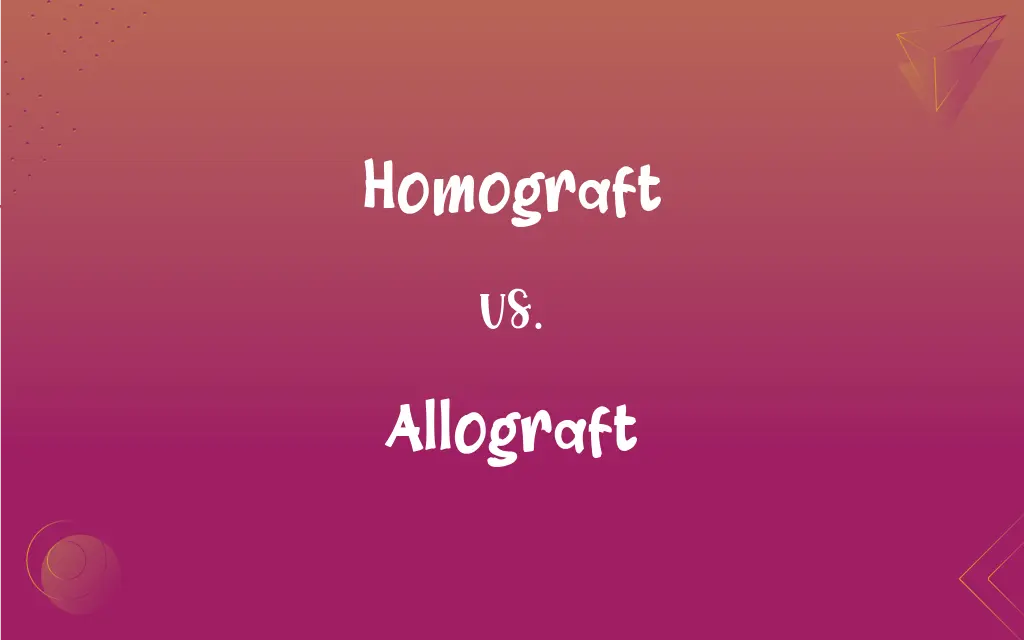Homograft vs. Allograft: What's the Difference?
By Janet White & Harlon Moss || Updated on March 4, 2024
Homograft and allograft both refer to tissue transplants from one individual to another within the same species, but "allograft" is more commonly used in modern medical terminology across various English-speaking regions.

Key Differences
The terms "homograft" and "allograft" are used in the field of transplantation to describe the transfer of tissue from one individual to another within the same species, such as from one human to another. Both terms have the same meaning and are often used interchangeably in clinical settings. However, "allograft" is the term more widely adopted in contemporary medical literature and discussions.
Historically, "homograft" was used more frequently, deriving from the Greek words "homos," meaning same, and "graft," implying the transplantation process. This term emphasizes the sameness of the species between the donor and the recipient. Over time, the term "allograft," combining the prefix "allo-" meaning "other" in Greek, with "graft," has become the preferred term in medical communities. "Allograft" highlights the concept of transferring tissue between different individuals of the same species, focusing on the donor and recipient being other than identical twins (in which case the term "isograft" would apply).
Despite the preference for "allograft" in modern medical terminology, understanding that "homograft" carries the same meaning is important for historical and educational contexts. The choice between the two terms largely depends on regional preferences, the specific medical community's convention, and the context in which the term is used.
Comparison Chart
Definition
Tissue transplant from one individual to another within the same species.
Tissue transplant from one individual to another within the same species.
Usage
Historically more common, but less so in contemporary medicine.
Preferred term in modern medical terminology.
ADVERTISEMENT
Origin
Derived from Greek "homos" (same) and "graft."
Derived from Greek "allo" (other) and "graft."
Context
Used interchangeably with allograft in clinical settings.
Widely used in organ and tissue transplantation discussions.
Implication
Emphasizes the sameness of the species.
Highlights the difference between individuals of the same species.
Homograft and Allograft Definitions
Homograft
A tissue transplant between two individuals of the same species.
The surgeon used a homograft to replace the damaged heart valve.
Allograft
A tissue transplant between non-identical individuals of the same species.
The allograft procedure was successful, and the patient's body accepted the new kidney.
ADVERTISEMENT
Homograft
Used in various types of tissue transplants.
Homografts are critical in treating severe burn victims by transplanting skin from donors.
Allograft
Supported by advances in immunology.
Advances in understanding allograft rejection have greatly improved transplant outcomes.
Homograft
Can be stored in tissue banks for future use.
The homograft was obtained from a tissue bank specializing in preserved donor tissues.
Allograft
Involves consideration of donor-recipient compatibility.
Matching the allograft to the recipient reduces the risk of rejection.
Homograft
Historically used term in transplantation.
Early studies on homograft skin transplantation provided valuable insights into rejection mechanisms.
Allograft
Preferred terminology in modern medicine.
Allograft compatibility is determined through extensive tissue typing before transplantation.
Homograft
Requires immunosuppression to prevent rejection.
Post-homograft, patients often undergo immunosuppressive therapy.
Allograft
Applies to organs, skin, bone, and other tissues.
Bone allografts are commonly used in orthopedic surgeries to repair or replace damaged bone.
Homograft
Synonym of allograft
Allograft
A tissue or organ graft between genetically different individuals of the same species, as between two humans. Also called homograft.
Homograft
Tissue or organ transplanted from a donor of the same species but different genetic makeup; recipient's immune system must be suppressed to prevent rejection of the graft
Allograft
(surgery) A surgical transplant of tissue between genetically different individuals of the same species.
Allograft
To perform a transplant of this kind.
Allograft
Tissue or organ transplanted from a donor of the same species but different genetic makeup; recipient's immune system must be suppressed to prevent rejection of the graft
FAQs
Why has "allograft" become the preferred term over "homograft"?
"Allograft" has become preferred due to its broader acceptance and use in medical literature and discussions, possibly because it more clearly distinguishes the transplant tissue as coming from another individual.
What are the challenges associated with homografts/allografts?
Challenges include potential rejection by the recipient's immune system, the need for immunosuppressive drugs, and ensuring donor-recipient compatibility.
Can homografts and allografts be used for the same types of transplants?
Yes, both terms apply to the same types of tissue and organ transplants within the same species, including skin, bone, and organs like kidneys or liver.
What is the main difference between a homograft and an allograft?
There is no difference in meaning; the main difference lies in the terminology preference, with "allograft" being more commonly used in modern medicine.
How are homografts/allografts obtained?
They are obtained from living donors or cadavers, with tissues being screened and stored in tissue banks until needed for transplantation.
Is there any type of graft that does not cause immune rejection?
An "isograft," or a transplant between genetically identical individuals (identical twins), is the only type that typically does not cause immune rejection.
What role do tissue banks play in allograft transplantation?
Tissue banks play a crucial role in screening, preserving, and distributing donor tissues for transplantation, ensuring they are safe and available when needed.
How has the field of transplantation evolved with the use of allografts?
The field has evolved significantly with improved understanding of immune rejection, better immunosuppressive therapies, and advances in tissue preservation, making allografts more successful.
How long can an allograft last in a recipient?
The longevity of an allograft varies by the type of tissue transplanted and individual patient factors. Some allografts, like kidneys, can last many years with proper care and monitoring, while others may have shorter functional lifespans.
Are there ethical considerations in obtaining allografts?
Yes, ethical considerations include consent from the donor or donor's family, equitable distribution of tissues, and transparency in how tissues are allocated.
What future advancements are anticipated in the use of allografts?
Future advancements may include further reducing the risk of rejection, developing synthetic or lab-grown tissues to supplement or replace allografts, and enhancing immunosuppressive therapies to improve transplant longevity and success.
What is the success rate of allograft transplants?
Success rates vary widely depending on the type of tissue transplanted, the recipient's health, the match between donor and recipient, and advancements in transplant medicine. Generally, success rates have improved over time with better matching techniques and post-transplant care.
What are the costs associated with allograft transplantation?
Costs can be substantial and include the surgery itself, hospital stays, immunosuppressive medications, and ongoing monitoring and care to prevent rejection.
What are the latest research trends in improving allograft outcomes?
Current research trends include developing tolerance-inducing therapies to reduce the need for lifelong immunosuppression, using stem cells to repair or regenerate transplanted tissues, and improving methods for preserving tissues to extend their viability before transplantation.
Can allografts transmit diseases from the donor to the recipient?
While rare, there is a risk of transmitting diseases, which is why donors are thoroughly screened for infectious diseases, and tissues are treated to minimize any risk of transmission.
What are the psychological impacts of receiving an allograft?
Receiving an allograft can have significant psychological impacts, including feelings of gratitude, concerns about the body's acceptance of the new tissue, and stress related to the possibility of rejection and the need for lifelong immunosuppression.
How do patients and doctors decide between using an allograft and other types of grafts?
The decision often depends on the specific medical condition, availability of donor tissues, potential for rejection, and the patient's overall health. Factors like the urgency of the transplant and compatibility with the donor also play crucial roles.
How do cultural beliefs affect perceptions of homografts and allografts?
Cultural beliefs can significantly influence perceptions and acceptance of homografts and allografts, with some cultures more open to the concept of organ donation and others having religious or philosophical reservations about receiving tissues from another person.
How do immunosuppressive drugs work in the context of allografts?
Immunosuppressive drugs work by dampening the recipient's immune response to the transplanted tissue, reducing the risk of rejection. These drugs must be carefully balanced to suppress rejection while not overly compromising the immune system.
What is the role of genetic matching in allograft transplantation?
Genetic matching plays a crucial role in reducing the risk of rejection. The closer the genetic match between the donor and recipient, the lower the likelihood of the recipient's immune system attacking the transplanted tissue.
About Author
Written by
Janet WhiteJanet White has been an esteemed writer and blogger for Difference Wiki. Holding a Master's degree in Science and Medical Journalism from the prestigious Boston University, she has consistently demonstrated her expertise and passion for her field. When she's not immersed in her work, Janet relishes her time exercising, delving into a good book, and cherishing moments with friends and family.
Co-written by
Harlon MossHarlon is a seasoned quality moderator and accomplished content writer for Difference Wiki. An alumnus of the prestigious University of California, he earned his degree in Computer Science. Leveraging his academic background, Harlon brings a meticulous and informed perspective to his work, ensuring content accuracy and excellence.































































